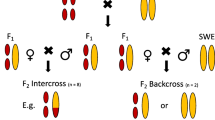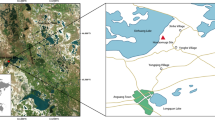Abstract
Traditionally comparative cytogenetic studies are based mainly on banding patterns. Nevertheless, when dealing with species with highly rearranged genomes, as in Akodon species, or with other highly divergent species, cytogenetic comparisons of banding patterns prove inadequate. Hence, comparative chromosome painting has become the method of choice for genome comparisons at the cytogenetic level since it allows complete chromosome probes of a species to be hybridized in situ onto chromosomes of other species, detecting homologous genomic regions between them. In the present study, we have explored the highly rearranged complements of the Akodon species using reciprocal chromosome painting through species-specific chromosome probes obtained by chromosome sorting. The results revealed complete homology among the complements of Akodon sp. n. (ASP), 2n = 10; Akodon cursor (ACU), 2n = 15; Akodon montensis (AMO), 2n = 24; and Akodon paranaensis (APA), 2n = 44, and extensive chromosome rearrangements have been detected within the species with high precision. Robertsonian and tandem rearrangements, pericentric inversions and/or centromere repositioning, paracentric inversion, translocations, insertions, and breakpoints, where chromosomal rearrangements, seen to be favorable, were observed. Chromosome painting using the APA set of 21 autosomes plus X and Y revealed eight syntenic segments that are shared with A. montensis, A. cursor, and ASP, and one syntenic segment shared by A. montensis and A. cursor plus five exclusive chromosome associations for A. cursor and six for ASP chromosome X, except for the heterochromatin region of ASP X, and even chromosome Y shared complete homology among the species. These data indicate that all those closely related species have experienced a recent extensive process of autosomal rearrangement in which, except for ASP, there is still complete conservation of sex chromosomes homologies.











Similar content being viewed by others
Abbreviations
- ACU:
-
Akodon cursor
- AMO:
-
Akodon montensis
- APA:
-
Akodon paranaensis
- ASP:
-
Akodon sp. n.
- DOP-PCR:
-
Degenerate oligonucleotide-primed PCR
- FISH:
-
Fluorescent in situ hybridization
- FN:
-
Fundamental number of autosomal arms
- ITS:
-
Interstitial telomeric sequences
- PCR:
-
Polymerase chain reaction
References
Chowdhary BP, Raudsepp T (2001) Chromosome painting in farm, pet and wild animal species. Methods Cell Sci 23:37–55
Christoff AU (1997) Contribuição à sistemática das espécies do gênero Akodon (Rodentia, Sigmodontinae) do leste do Brasil: estudos anatômicos, citogenéticos e de distribuição geográfica. Tese de Doutorado. Departamento de Biologia, Instituto de Biociências, Universidade de São Paulo, São Paulo
Fagundes V, Vianna-Morgante AM, Yonenaga-Yassuda Y (1997a) Telomeric sequences localization and G-banding patterns in the identification of a polymorphic chromosomal rearrangement in the rodent Akodon cursor (2n = 14, 15 and 16). Chromosome Res 5:228–232
Fagundes V, Scalzi-Martin JM, Sims K, Hozier J, Yonenaga-Yassuda Y (1997b) ZOO-FISH of a microdissection DNA library and between the Brazilian rodents Akodon cursor and A. montensis. Cytogenet Cell Genet 78:224–228
Fagundes V, Christoff AU, Yonenaga-Yassuda Y (1998) Extraordinary chromosomal polymorphism with 28 different karyotypes in the neotropical species Akodon cursor (Muridae, Sigmodontinae), one of the smallest number in rodents (2n = 16, 15 and 14). Hereditas 129:263–247
Ford CE, Hamerton JL (1956) A colchicine hypotonic citrate squash sequence for mammalian chromosomes. Stain Technol 31:247–251
Geise L, Canavez FC, Seuánez HN (1998) Comparative karyology in Akodon (Rodentia, Sigmodontinae) from Southwestern Brazil. J Hered 89:158–163
Geise L, Smith MF, Patton JL (2001) Diversification of genus Akodon (Rodentia: Sigmodontinae) in southeastern South America: mitochondrial DNA sequence analysis. J Mammal 82:92–101
Glas R, de Leo AA, Delbridge ML, Reid K, Ferguson-Smith MA, O'Brien PCM, Westerman M, Graves JAM (1999) Chromosome painting in marsupials: genome conservation in the kangaroo family. Chromosome Res 7:167–176
Hass I, Sbalqueiro JI, Muller S (2008) Chromosomal phylogeny of four Akodontini species (Rodentia, Cricetidae) from Southern Brazil established by Zoo-FISH using Mus musculus (Muridae) painting probes. Chromosome Res 16(1):75–88
Kasahara S, Yonenaga-Yassuda Y (1984) A progress report of cytogenetic data on Brazilian rodents. Rev Bras Genet 63:156–159
Li T, O'Brien PCM, Biltueva L, Fu B, Wang J, Nie W, Ferguson-Smith MA, Graphodatsky AS, Yang F (2004) Evolution of genome organizations of squirrels (Sciuridae) revealed by cross-species chromosome painting. Chromosome Res 12:317–35
Muller S, Stanyon R, O'Brien PCM, Ferguson-Smith MA, Plesker R, Wienberg EJ (1999) Defining the ancestral karyotype of all primates by multidirectional chromosome painting between tree shrews, lemurs and humans. Chromosoma 108:393–400
Ruiz-Herrera A, Nergadze SG, Santagostino M, Giulotto E (2008) Telomeric repeats far from the ends: mechanisms of origin and role in evolution. Cytogenet Genome Res 122:219–228
Sbalqueiro IJ (1989) Análises cromossômicas e filogenéticas em algumas espécies de roedores da região sul do Brazil. PhD Thesis. Universidade Federal do Rio Grande do Sul. Porto Alegre. Brazil
Sbalqueiro JI, Nascimento AP (1996) Occurrence of Akodon cursor (Rodentia, Cricetidae) with 14, 15 and 16 chromosome cytotypes in the same geographic area in South Brazil. Braz J of Genet 19(4):565–569
Silva MJJ, Yonenaga-Yassuda Y (1998) Karyotype and chromosomal polymorphism of a undescribed Akodon from Central Brazil, a species with the lowest known diploid chromosome number in rodents. Cytogenet Cell Genet 81:46–50
Silva MJJ, Patton JL, Yonenaga-Yassuda Y (2006) Phylogenetic relationships and karyotype evolution in the sigmodontine rodent Akodon with (2n = 10 and 2n = 16) from Brazil. Genet Mol Biol 29(3):469–474
Smith MF, Patton JL (2007) Molecular phylogenetics and diversification of South American grass mice, genus Akodon. In: Kelt DA, Lessa EP, Salazar-Bravo J, Patton J (eds) The quintessential naturalist: honoring the life and legacy of Oliver P. Pearson. University of California Publications in Zoology, vol 34. University of California Press, Berkeley, pp 827–858
Telenius H, Pelmear A, Tunnacliffe A et al (1992) Cytogenetic analysis by chromosome painting using DOP-PCR amplified flow-sorted chromosomes. Genes Chromosomes Cancer 4:257–263
Tian Y, Nie W, Wang J, Ferguson-Smith MA, Yang F (2004) Chromosome evolution in bears: reconstructing phylogenetic relationships by cross-species chromosome painting. Chromosome Res 12:55–63
Ventura K, Silva MJJ, Fagundes V, Christoff UA, Yonenaga-Yassuda Y (2006) Non-telomeric sites as evidence of chromosomal rearrangement and repetitive (TTAGGG) n arrays in heterochromatic and achromatic regions in four species of Akodon (Rodentia, Muridae). Cytogenet Genome Res 115(2):169–175
Vieira A, Ortiz MI, Oinna-Senn E, Dalmasso G, Bella JL, Lisanti JA (2004) Chromosomal localization of telomeric sequences in three species of Akodon (Rodentia, Sigmodontinae). Cytogenet Genome Res 107:99–10
Yang F, Carter NP, Shi L, Ferguson-Smith MA (1995) A comparative study of karyotypes of muntjacs by chromosome painting. Chromosoma 103:642–652
Yang F, Alkalaeva EZ, Perelman PL, Pardini AT, Harrison WR, O’Brien PCM, Fu B, Graphodatsky AS, Ferguson-Smith MA, Robinson TJ (2003) Reciprocal chromosome painting among human, aardvark, and elephant (superorder Afrotheria) reveals the likely eutherian ancestral karyotype. PNAS 100:1062–1066
Yonenaga Y (1972) Chromosomal polymorphism in the rodent Akodon arviculoides ssp. (2n = 14) resulting from two pericentric inversions. Cytogenetics 11:448–499
Yonenaga Y, Kasahara S, Almeida EJC, Peracchi AL (1975) Chromosomal banding patterns in Akodon arviculoides (2n = 14), Akodon sp. (2n = 24 and 25), and two male hybrids with 19 chromosomes. Cytogenet Cell Genet 15:388–399
Yonenaga-Yassuda Y (1979) New karyotypes and somatic and germ-cell banding in Akodon arviculoides (Rodentia, Cricetidae). Cytogenet Cell Genet 23:241–249
Acknowledgements
We thank Dr. Willem Rens, Margaret Wallduck, Frances Lovell, and Laura Hirst for the valuable contributions during the lab work and data analysis. We also thank Dr. Maria José de Jesus Silva and Dr. Valéria Fagundes for the Akodon sp. n., A. cursor and A. montensis G-banding karyotypes and Silvia Sousa da Costa for technical assistance with the cell cultures. Permit for cell lines transportation was provided by IBAMA. Grants were received from the Conselho Nacional de Desenvolvimento Científico e Tecnológico (CNPq) and Fundação de do Amparo à Pesquisa Estado de São Paulo (FAPESP). The Cambridge Resource Center for Comparative Genomics was supported by a grant to MAFS from the Wellcome Trust.
Author information
Authors and Affiliations
Corresponding author
Additional information
Responsible Editor: Fengtang Yang.
Rights and permissions
About this article
Cite this article
Ventura, K., O’Brien, P.C.M., Yonenaga-Yassuda, Y. et al. Chromosome homologies of the highly rearranged karyotypes of four Akodon species (Rodentia, Cricetidae) resolved by reciprocal chromosome painting: the evolution of the lowest diploid number in rodents. Chromosome Res 17, 1063–1078 (2009). https://doi.org/10.1007/s10577-009-9083-5
Received:
Revised:
Accepted:
Published:
Issue Date:
DOI: https://doi.org/10.1007/s10577-009-9083-5




